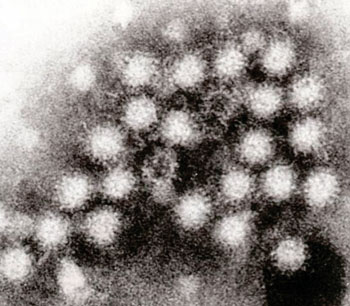Molecular Assay Evaluated for Norovirus Detection
By LabMedica International staff writers
Posted on 03 Jul 2014
A commercial real-time polymerase chain reaction (RT-PCR) assay has been evaluated for the detection of noroviruses for use in a routine diagnostic laboratory. Posted on 03 Jul 2014
The noroviruses (NoVs), which are now recognized as a major cause of both sporadic cases and outbreaks of gastroenteritis, are single-stranded positive-sense ribonucleic acid (RNA) viruses classified as the genus Norovirus within the family Caliciviridae.

Image: Transmission electron micrograph of Norovirus particles in feces (Photo courtesy of Graham Colm).
Communicable disease specialists at the Victorian Infectious Diseases Reference Laboratory (Melbourne, Australia) tested 100 fecal specimens positive for NoV by open reading frames (ORF) 1 RT-PCR. A second group comprised of 100 fecal specimens negative for NoV by RT-PCR protocols. A third group comprised of 16 fecal specimens, which were selected as a specificity control to evaluate the assay for cross-reactivity to common fecal viruses other than NoV.
The commercial assay under evaluation was the RIDAGENE norovirus (NoV) real-time polymerase chain reaction assay (R-Biopharm; Darmstadt, Germany). The scientists found that the assay was straightforward to perform. For a run of 50 specimens, the PCR component took about one hour. Thus, with initial fecal processing and subsequent RNA extraction, a result could be obtained in roughly four hours for a run of 50 specimens. The RIDAGENE assay had an overall sensitivity of 98% but was more sensitive for GII than GI NoV and the assay had a specificity of 98%. The assay did not cross react with a number of gastroenteritis viruses including adenovirus, astrovirus, Rotavirus, and Sapovirus.
The author concluded that the RIDAGENE assay proved straightforward to use and time efficient. The assay had good sensitivity and specificity and can be recommended as a valuable detection method for NoV in a diagnostic laboratory. The study was published on the July 2014 edition of the journal Diagnostic Microbiology and Infectious Disease.
Related Links:
Victorian Infectious Diseases Reference Laboratory
R-Biopharm













